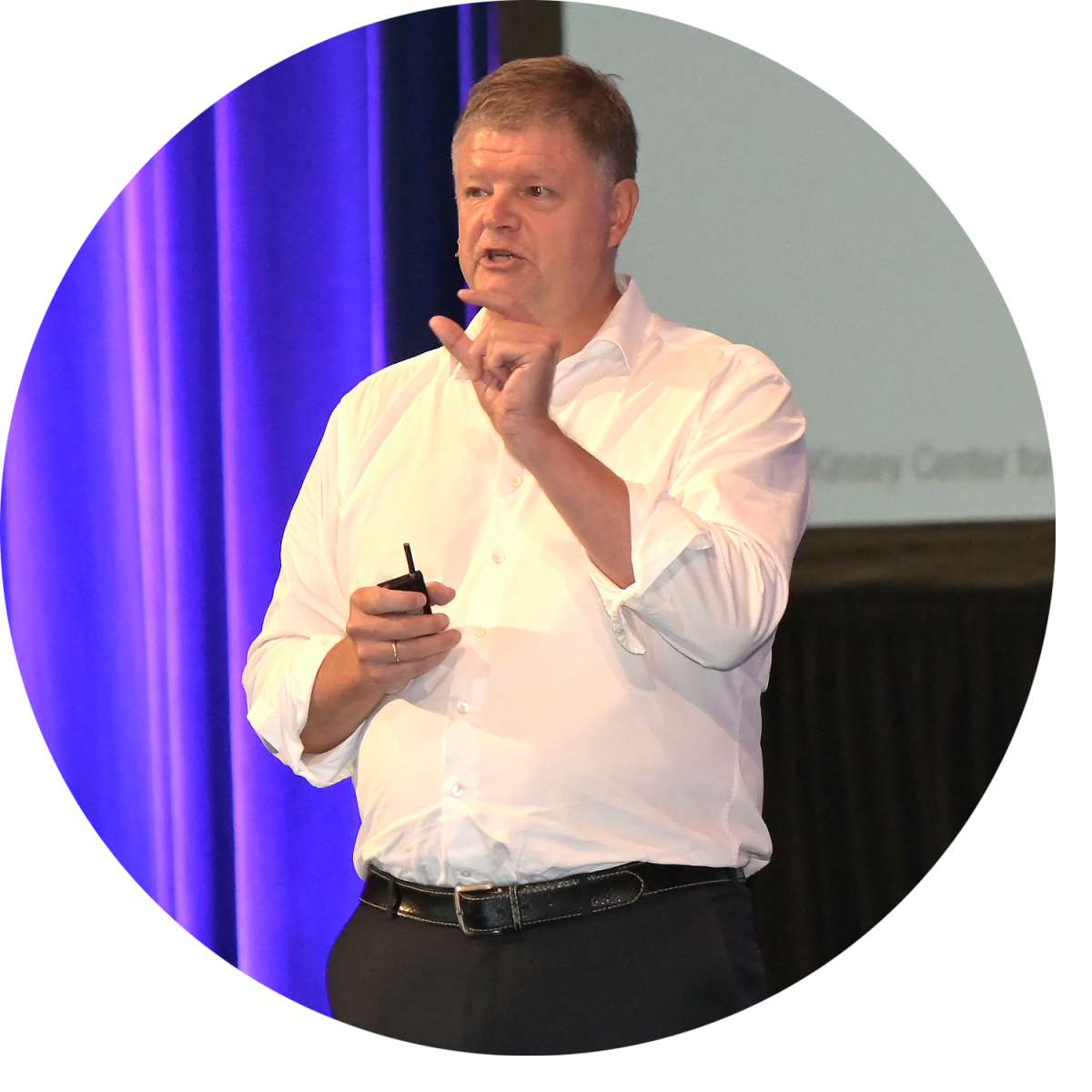New this year to the NACS Show were two educational Super Sessions designed to appeal to the visionary leaders in the convenience and fuel retailing industry willing to stretch their thinking and step out of their comfort zones toward long-term success.
In the first Super Session, Jacob Schram, industry veteran and a senior advisor for McKinsey & Company, spoke about the future of mobility and the radical changes it will bring to the c-store format. The second Super Session featured Zeynep Ton, a professor at the MIT Sloan School of Management and co-founder of the Good Jobs Institute, who shared key elements that drive a capable and motivated workforce.
 Reimagining Mobility
Reimagining Mobility
Jacob Schram
McKinsey & Company, former Circle K president
Industry veteran Jacob Schram came to the NACS Show to talk not about a doomsday scenario for convenience and fuel retailers but one of tremendous opportunity as electric vehicles, soon-to-come autonomous vehicles, connected vehicles and shared vehicles remake the vehicle fleet in the U.S.—and consumer habits.
The making of a revolution is here in transportation. Autonomous cars, electrified cars and shared cars—these are the three things driving mobility.
In the Day 2 Super Session, “Reimagining Mobility 2020-2030,” Schram took the NACS audience on a journey through the great inflection points in transportation history. Schram, who hails from Norway—the most electrified country in Europe, he said—is senior advisor, McKinsey & Company, and former group president of European operations at Circle K.
Schram predicts that by 2030, the convenience industry will see developments that are as profound as those of a hundred years before. Think the shift from horse and buggy to automobile. It’s what Schram calls “mobility’s first great inflection point.” Cutting-edge changes are coming even faster this time, Schram said, resulting in a dramatically different mobility—and competitive—landscape.
“The making of a revolution is here in transportation,” Schram said. “Autonomous cars, electrified cars and shared cars—these are the three things driving mobility.”
When it comes to EVs, the U.S. lags behind China and Europe in their uptake, but the day is coming when consumers will choose EVs—or no vehicle at all—over conventional fuel-powered vehicles. How do retailers prepare for a future in which consumers may not need to stop by the gas station or convenience store to fill up their tanks?
First, realize that there will be “huge new job opportunities and new profit pools,” Schram said. “I’m not talking here about doomsday. There is only opportunity here for people who grab it.”
At present, China is winning the EV race, he said. Schram sees China as the leading market for EVs through 2030. In China, EVs account for about 7% of total new car sales. “There is no doubt to me that the new mobility is coming to China first,” Schram said.
To his international audience, Schram advised, “You will still sell fuel beyond 2030. I’m not saying you’re not going to sell fuel. What I am saying is that the fuel demand will diminish, and you will sell less fuel 10 years from now.”
So when can retailers expect the shift? “When there is price parity” between EVs and conventional vehicles. In Norway, he said, the fleet went from zero to roughly 60% EVs in about seven years. “Nobody, absolutely nobody, believed that would happen when it started,” he said. Schram predicts the U.S. market will see price parity around 2022 as $34,000 is the average price of a new car now. “Don’t talk about price parity being far out in the future. This is coming.” Government incentives and regulations can accelerate this timeline, he noted.
So-called range anxiety is fast disappearing, too, as auto companies introduce cars with higher-capacity batteries. “The tipping point is supposed to be 320 kilometers (199 miles). The Tesla Model 3, for example, has a range of about 310 miles before needing a charge, while the Audi e-tron can go for about 204 miles.
Switching from a conventional vehicle to an electric one still can be daunting if there aren’t convenient places to recharge. In the U.S. and Europe, the charging infrastructure needs building out to fuel demand for EVs. “A key number to remember to have balance between electric cars and chargers is 100 cars per fast charger,” Schram said. In the U.S., there are 265 EVs for every available fast charger, but in China that number is 20 cars per fast charger, he said. “They have a lot of fast chargers; however, the demand for electric cars is so big that they need to go on,” Schram said.
“Charging is actually good business,” Schram said, explaining that retailers can reap higher margins on selling electricity than fuel. At Circle K in Norway, “we have really fast payback on our chargers.”
There is no doubt to me that the new mobility is coming to China first.
To remain relevant to EV drivers—and eventually autonomous vehicle users—convenience retailers need to keep up a dialogue with them—remind them of your brand. Invest in on-the-go charging hubs, create urban mobility hubs and offer in-car services related to entertainment, relaxation and foodservice.
“I think what’s happening in mobility now gives us the chance to take back the cities,” Schram offered, pointing out that municipal governments that once turned away traditional gasoline stations might welcome c-stores with EV-charging hubs and space for autonomous vehicles waiting for their next pickup.
Don’t stop there. “In my view you need to go all the way to home charging,” Schram said. “We can’t stand behind the cash register waiting for the electric cars to come. Go home to them. Establish [your brand] in their basement,” he said. “Grab this opportunity. Don’t let it go.”
At the same time, optimize your current business—focus on developing premium fuel, developing enhanced rewards programs and the like. But keep an eye on the future—don’t miss the opportunity. “You own the space,” he said.
The bottom line is that “yes, mobility will change,” Schram said. “I believe it will happen even faster than when we went from horses to cars. You have a choice of being disruptive or taking the opportunity. You have massive skills. You are the right owners who will benefit from the revolution that’s coming.”
 The Good Jobs Strategy
The Good Jobs Strategy
Zeynep Ton
MIT professor, founder Good Jobs Institute
Zeynep Ton has a keen sense of observation. When she steps inside a convenience store, the first thing she notices is the speed at which employees work in their effort to serve busy customers. Those keen observations, combined with her two decades of studying retail operations, captivated the crowd on Day 3 at the “The Good Jobs Strategy” Super Session.
Ton, a native of Turkey, author, professor at the MIT Sloan School of Management and co-founder of the Good Jobs Institute, offered an impassioned look at why retailers should invest in their employees. It pays off financially, competitively and morally, she said.
“Regardless of company size, competitive advantage comes from creating a highly satisfied and loyal customer who has a compelling reason to shop at your store,” Ton said. “Operational excellence is the key to achieving this type of environment.”
Some barriers to operational excellence are due to the complexities of the retail sector. But the biggest barrier is people, specifically high turnover, insufficient training and being short-staffed. Thus, it makes sense to focus on your people.
Low wages are the most glaring cause of turnover, Ton said. That’s a difficult pill to swallow for retailers who are concerned about profit margins. But Ton says research shows that putting your employees first positively impacts your bottom line.
According to Ton, 42 million people work in a service industry, such as retail, where the average hourly wage is $11.33. Beyond low wages, retail employees are subjected to unstable work hours, further putting a strain on personal and family lives. Turnover is inevitable, she said.
“If a person’s basic needs aren’t met, they can’t put food on the table, they can’t count on a stable schedule, and if they don’t feel safe physically or psychologically, they’re going to leave,” Ton said. “When you’re constantly hiring and retraining, you’re just fighting fires. You’re not managing your business.”
Employees crave meaningful work with opportunities for growth, a sense of belonging and recognition.
“We can’t see convenience store jobs, retail jobs as a stepping stone anymore to good jobs,” Ton said. “If we want to create a strong middle class in the United States we can’t do that without improving these jobs.”
Research shows that putting your employees first positively impacts your bottom line.
She hailed a number of retailers who have established reputations for providing decent wages and retaining loyal employees, including QuikTrip, Costco, Trader Joe’s and Mercadona, a retail chain in Spain. Mercadona, for example, pays almost double the average wage in Spain and has an impressive turnover rate of 3.8%.
Ton doesn’t believe paying higher wages alone is the path to success. Additional ways to achieve operational excellence, including focusing and simplifying your store’s products, are also key contributions. That may mean offering fewer SKUs that employees can knowledgeably and compellingly sell to customers.
Operational excellence impacts more than the bottom line, however. Ton made her own compelling case for investing in good people.
“Your sector can make a huge difference for our society,” she said. “There’s a healing power to retail. Every single day, 165 million customers visit your stores. People from all walks of life come to your store. Those 165 million could magnify our differences with negative interactions or bring us together through positive interactions. In this divided country, we need you more than ever.”